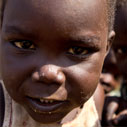In five hours it will be time to get up for introductory lectures, but every late night hour working on editing pictures has been worth it. Most of the pictures have stories, and many of those stories will be told in coming posts – just as soon as Telkom (that’s the company that controls phone lines in South Africa for overseas readers) deigns to visit internet connectivity upon my house. For now though, days of adjusting exposure, black point and god-alone-remembers-what-else means that there is a lot to start looking at. Here is an overview.
First up, I have a photo essay going live in a matter of hours over at Matador Nights on full-body suspension. That thing where suitably motivated individuals pierce themselves with rather large hooks and hang from ropes off the ceiling. The pictures were actually taken last year, but it’s taken me this long to realise that they might be a fit for Nights. So here’s hoping that they hit the mark and provoke a response.
Then – and most proudly – the first tranche of images from Uganda are now ready.
Then – and most proudly – the first tranche of images from Uganda are now ready. Divided into two sets, they cover a couple of bigger events that Tom, Saskia and I were fortunate to be invited to cover while we were in Gulu. The first is an album of photographs taken in a camp for internally displaced people (IDPs) called Cope (pronounced Cho – Pey). IDPs are essentially refugees that have not managed to cross an international boundary, and camps like Chope were established by the Ugandan government as a way of coralling the population in Northern Uganda to make dealing with the Lord’s Resistance Army easier. Many camps were ill-equipped to deal with the influx of people after the government gave them a province-wide 48-hour deadline to leave everything and relocate. Lacking basic sanitation, medical care and even shelter, camps like Cope would become places where many of those fleeing the LRA would end up dying from cholera or being raped by bored government soldiers.
Although technically closed now, many camps still contain dozens of families who are unable to leave for various reasons. Some are too young to remember the areas they originally came from, while others are too old to leave, or are unable to claim back their land from groups who have since claimed it. Women are particularly vulnerable to being unable to assert their title to land without a husband or father to press the issue. Culturally, the destruction of families through LRA abductions and life in the camps has meant that many younger Acholi have become detached from the traditions and history of the group as a whole. When we visited Cope, it was to see work that elders have been undertaking to try and keep the youth involved in community life and maintaining Acholi identity. In particular, in the case of Cope camp, the establishment of a local dance troupe has provided an activity for many of the younger residents to become involved in. The various dances practiced are linked to stories and customs in Acholi life and through participation, act as a means of ensuring that identity and history are passed on.
Naomi, one of our contacts in Uganda, managed to score a ‘Vote Timothy Okeny’ shirt. Tom and I had to settle for flyers.
The second album contains photographs from the opening campaign rally of Timothy Okeny, the successful owner of a microloan company in Gulu who is contesting local elections in the town. While incumbent president Yoweri Museveni has ensured that the top spot in the national elections is largely inevitable, many local regions are wide open to competition between parties. This is particularly true in the North, where support for candidates aligned with Museveni’s party has never been particularly strong. For the 2011 elections though, the president has been trying unusually hard to court voters in Gulu and surrounding provinces, to make up for failing support amongst the Baganda group further south, with whom he had recently fallen out. To cut a long story short, candidates who would never otherwise be able to beat the incumbent party machine are campaigning in force throughout Gulu in the run up to the ballot in February. The rally we were invited to attend was a mix of hearing community grievances, listening to Timothy give a rousing speech, and traditional dance performances. Naomi, one of our contacts in Uganda, managed to score a ‘Vote Timothy Okeny’ shirt. Tom and I had to settle for flyers. I managed to make a cover for my journal out of a large one.
Finally, while these two albums contain most of the images that I have so far been able to process, they are a small fraction of the total. Many others would be great, but are not well-enough composed or executed to be included in a collection for presentation. Others I have yet to even look at. But tonight, somewhere between midnight and two am, I culled a bunch of the ugly ducklings and a few swans and put them together with sound recorded while waiting in the bus park in Kitgum for the bus back to Kampala. It’s rough, but it reflects a little more of the idiosynchrasies of our journey from day to day and will hopefully make you smile in places. And then pine to see Uganda. You really should – it’s quite something.

